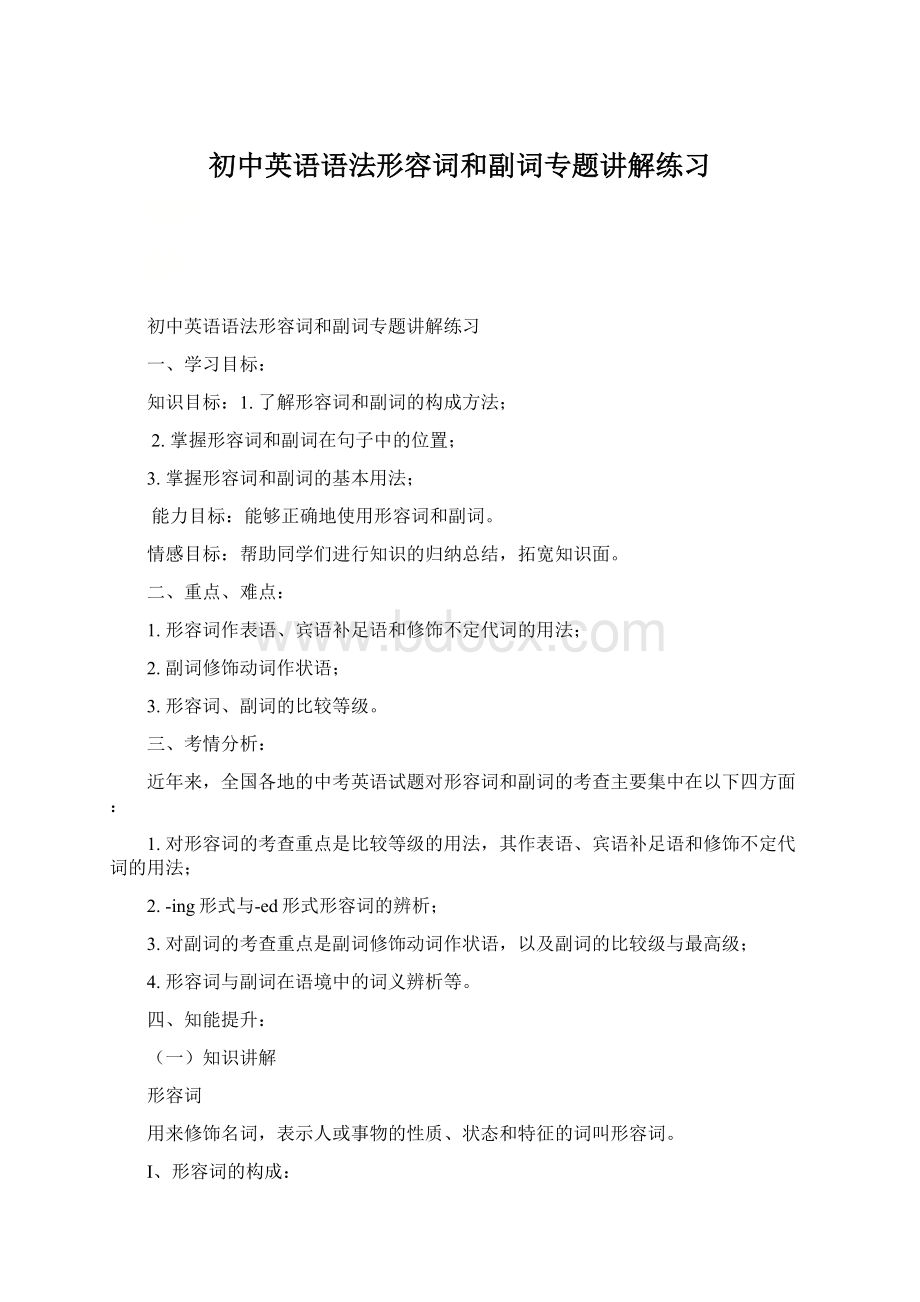初中英语语法形容词和副词专题讲解练习.docx
《初中英语语法形容词和副词专题讲解练习.docx》由会员分享,可在线阅读,更多相关《初中英语语法形容词和副词专题讲解练习.docx(12页珍藏版)》请在冰豆网上搜索。

初中英语语法形容词和副词专题讲解练习
初中英语语法形容词和副词专题讲解练习
一、学习目标:
知识目标:
1.了解形容词和副词的构成方法;
2.掌握形容词和副词在句子中的位置;
3.掌握形容词和副词的基本用法;
能力目标:
能够正确地使用形容词和副词。
情感目标:
帮助同学们进行知识的归纳总结,拓宽知识面。
二、重点、难点:
1.形容词作表语、宾语补足语和修饰不定代词的用法;
2.副词修饰动词作状语;
3.形容词、副词的比较等级。
三、考情分析:
近年来,全国各地的中考英语试题对形容词和副词的考查主要集中在以下四方面:
1.对形容词的考查重点是比较等级的用法,其作表语、宾语补足语和修饰不定代词的用法;
2.-ing形式与-ed形式形容词的辨析;
3.对副词的考查重点是副词修饰动词作状语,以及副词的比较级与最高级;
4.形容词与副词在语境中的词义辨析等。
四、知能提升:
(一)知识讲解
形容词
用来修饰名词,表示人或事物的性质、状态和特征的词叫形容词。
Ⅰ、形容词的构成:
1.本身即为形容词的词(如red,glad,nice,beautiful)
2.由“名词+y”构成的形容词
sun→sunnywind→win
dyfun→funnycloud→cloudy
noise→noisyluck→lucky
3.加后缀构成的形容词
(如-able,-ent,-en,-al,-ful,-less等)
comfort→comfortablenation→nationalwood→woodendiffer→different
care→carefulhope→hopeless
4.由“名词+ly”构成的形容词
friend→friendly
Ⅱ、形容词的用法及位置
<一>作定语
形容词修饰名词时放于名词之前;修饰不定代词时,放于不定代词之后。
如:
1.Whatbeautifulflowers!
2.Thenicegirlismysister.
3.Hewantstodosomethingdifferentthistime.
4.Ihavesomethingimportanttotellyou.
【考题链接】
①Shirleyhasdonealotforthetourists.Sheisreallya(help)guide.
答案:
helpful
解题思路:
guide“导游”,是一个名词,其前应用形容词作定语来修饰。
②Asweknow,LiuXiangisa(成功的)player.
答案
:
successful
解题思路:
句意“众所周知,刘翔是一个成功的运动员”。
player是一个名词,前面“成功的”应该用形容词形式,形容词作定语来修饰名词。
<二>作表语
在be动词、感官动词taste(尝起来),smell(闻起来),sound(听起来),look(看起来),feel(摸上去)以及get,turn等系动词后用形容词作表语。
如:
Heisyo
ung.
Shelookshappytoday.
Thefoodtastesdelicious.
【考题链接】
①Theoldwomanlooked(着急的)becauseshecouldn’tfindherpurse.
答案:
worried
解题思路:
句意“那位老太太看上去很着急,因为她找不到她的钱包了”。
look在本句中是感官动词,意为“看起来”,其后要接形容词作表语。
②Thedishsmellsandyou’dbetterthrowitaway.
A.goodB.wellC.badD.badly
答案:
C
解题思路:
句意“这道菜闻起来味道不好,你最好把它扔掉”。
smell在本句中是感官动词,意为“闻起来”,其后要接形容词作表语。
D.badly副词;B.well作形容词,表示“身体好的”,作副词,表示“好的”,不合题意;A.good形容词“好的”,不合题意。
所以选C。
<三>作宾语补足语
放在宾语之后,常与make,leave,keep等动词连用。
如:
Youshouldkeepyourroomcleaneveryday.
Whatmakesyousad?
Don’tleavethedooropenwhenyougoout.
【考题链接】
Yourroomisverydirty.Youshouldkeepit.
A.cleanB.dryC.quiet
答案:
A
解题思路:
根据句意“你的房间很脏。
你应该保持它的干净”。
可知选A。
keep+宾语+形容词作宾语补足语。
Ⅲ、-ing形式与-ed形式形容词的辨析
-ed形容词多形容人的情绪或感受,主语一般是人。
-ing形容词多形容客观事物体现在外的性质,主语或修饰的词一般是物。
【考题链接】
Nancydoesn’tenjoyherjobanymore.She’sbecauseeverydayshedoesexactlythesamething.
A.relaxingB.relaxedC.boringD.bored
答案:
D
解题思路:
-ed形容词的主语一般是人,-ing形容词的主语或它所修饰的词一般是物。
首先排除A和C;根据前句意思“Nancy不再喜欢她的工作”,可判断是“厌烦了”,因此选D。
[即学即练]
1.—Look!
Howtheboysare!
—Yes.Theywonthegamethisafternoon.
A.excitingB.excitementC.exciteD.excited
2.Wholeftthewindows?
A.openB.openingC.openedD.opens
3.—Mum,Billiscomingtodinnerthisevening.
—OK.Let’sgivehimtoeat.
A.somethingdifferentB.differentanythingC.anythin
gdifferentD.differentsomething
4.Thesealooksvery
whenthesunisshiningonit.
A.beautifulB.morebeautifulC.themostbeautiful
5.Shetoldusastory.Hervoicesounded.
A.sweetB.smallC.clearlyD.sadly
6.Georgewasfrightenedtoseeasnakeinthegrass.Hisfaceturned.
A.paleB.cleanC.sadlyD.happily
7.HarryPotterisanbookforchildren,butmycousinisn’tinitatall.
A.interesting;interestingB.interested;interested
C.interesting;interestedD.interested;interesting
8.Ilikeworkingherebecauseeveryoneis(friend).
9.TheGreensare(happy)toliveinthis(noise)street.Theywanttomovetoanotherplace.
10.Susanoftengoesswimminginsummerwhenit’swarmand(sun).
副词
修饰动词、形容词、其他副词或句子,说明时间、地点、程度、方式等概念的词称为副词。
Ⅰ、副词的分类:
1.时间副词
(1)表示何时:
now,today等(表现在)
then,yesterday,lastnight,…ago,justnow,amomentago等(表过去)
tomorrow,nextweek,tonight等(表将来)
这类副词是确定动词时态的标志,是解题的突破口。
(2)表示频度:
always,usually,often,sometimes,never,everyday,hardly,twiceaweek等。
(3)表示其他时间关系:
already,early,since,still,atonce,atfirst,atlast等。
2.地点副词
here,there,home,upstairs,downstairs,somewhere等。
3.方式副词一般用来回答“怎样地”这类问题,像well,hard,slowly等。
4.程度副词多用于修饰形容词、副词、动词或介词短语。
常见的有much,alittle,abit,very,too,enough,quite等。
5.疑问副词
how,when,where,why用于引导一个特殊疑问句,提出疑问。
另有由how组成的疑问副词短语howoften,howfar,howsoon,howlong,howmuch等。
Ⅱ、副词的构成
1.本身即为副词:
now,very,there,how,too等。
2.与形容词形式相同的副词:
early,late,high,wide等。
3.由“形容词+ly”构成的副词:
slow→slowlyquick→quicklyclear→clearlybad→badly
4.一些形容词本身即可作副词,而加ly之后也为副词,但意义不同。
如:
hard努力地,狠狠地hardly几乎不;wide宽地widely广泛地;high高高地highly高度地
Hisparentshithimhard.
Hisparentshardlyhithim.
5.有些以ly结尾的词是形容词,而不是副词。
如:
friendly(友好的);lonely(孤独的);lovely(可爱的)
6.有些形容词和副词同形
因为这类词的形容词和副词同形,所以要看它在句中具体修饰什么词来判断它到底是形容词还是副词。
Thiskindofwoodishard.这种木材硬。
Hestudieshard.他努力学习。
Helookswell.看起来他身体不错。
Heworkswell.他工作得很好。
Ⅲ、副词在句中的作用
副词在句中主要修饰动词、形容词,作状语。
Heworkshard.
It’srainingheavily.
Youarequiteright.
Theboyistooyoung.
【考题链接】
①Hand-foot-mouthdiseaseisterrible,butIbelievethatweChinesecanbeatit(成功地).
答案:
successfully
解题思路:
副词在谓语动词之后作状语。
②He’ssostrongthathecancarrythebox(容易地).
答案:
easily
解题思路:
副词在谓语动词之后作状语。
Ⅳ、副词的位置
1.一般副词作状语时,放在谓语动词之后。
如果谓语动词后带宾语,则放在宾语后面。
Heisjumpinghappily.
Theboyisdoinghishomeworkcarefully.
2.地点副词、时间副词和方式副词一般放在句尾。
Theylivehere.
I’llmeethimatthestationtomorrow.
Theboyrunsquickly.
Theydidtheirexperimentscarefullyinthelabyesterday.
3.频率副词在句中的位置
在be动词、情态动词、助动词之后,行为动词之前。
Sheisalwayskindtous.
Icanneverforgettheday.
Theworkhasneverbeendone.
Heoftengoestoschoolearly.
4.修饰全句的副词一般位于句首,用来修饰整个句子,表示说话人对话语的态度。
Luckily,shewasinwhenIcalled.
5.enough修饰形容词、副词时,要放在所修饰词之后。
Theroomisbigenoughtoholdfiftypeople.
Herunsfastenough.
【考题链接】
Don’tworry.HeistolookafterlittleBetty.
A.carefullyenoughB.enoughcarefulC.carefulenoughD.enoughcarefully
答案:
C
解题思路:
enough作副词修饰形容词或副词时,要放在所修饰词的后面,所以排除B和D。
空白处前面是be动词,因此应该填形容词。
故选C。
[即学即练]
1.—Look,it’sraining.
—That’sgreat.It’stoohotthesedays.
A.greatlyB.heavilyC.quicklyD.hardly
2.theweatherwasnotsowetasitistodayandweplayedhappily.
A.LuckyB.LuckilyC.UnluckyD.Unluckily
3.I’msureI’veseenhim,butIcan’tremembertherightplace.
A.anywhereB.nowhereC.somewhereD.everywhere
4.Ididn’tsleeplastnight.Ifeeltirednow.
A.wellB.niceC.fineD.good
5.—MrLiisverypopularamongthestudents.
—Yes.Hisclassesarelivelyandinteresting.
A.alwaysB.sometimesC.hardlyD.never
6.—Mum,IthinkI’mtogetbacktoschool.
—Oh,dear.You’dbetterstayathomeforanothe
rdayortwo.
A.sowellB.sogoodC.wellenoughD.goodenough
7.ThoughhestudiedatRussianfortenmonths,hecanstillspeakthelanguage.
A.hard;hardB.hardly;hardlyC.hard;hardlyD.hardly;hard
8.—doyoulikethemovie?
—Veryinteresting.
A.HowB.WhoC.WhatD.When
Ⅴ、形容词和副词的级
大多数形容词和副词有原级、比较级和最高级。
原级即形容词或副词的原形,比较级和最高级的构成如下:
1.规则变化
类别
构成方法
原级
比较级
最高级
单音节词和少数双音节词
一般直接加-er,-est
long
tall
Longer
Taller
longest
tallest
以不发音的e结尾时加-r,-st
late
large
later
larger
latest
largest
以辅音字母加y结尾时,把y变i,再加-er,-est
easy
happy
easier
happier
easiest
happiest
以重读闭音节结尾且末尾只有一个辅音字母时,双写最后的辅音字母,再加-er,-est
big
hot
bigger
hotter
biggest
hottest
多音节词和部分双音节词
在原级前加more,most
careful
morecareful
mostcareful
beautiful
morebeautiful
mostbeautiful
2.以ly结尾的副词,除early外,比较级、最高级都用在其前加more,most的形式。
原级
比较级
最高级
early
earlier
earliest
slowly
moreslowly
mostslowly
quickly
morequickly
mostquickly
bravely
morebravely
mostbravely
3.不规则变化。
原级
比较级
最高级
good/well
better
best
many/much
more
most
little
less
least
bad/badly/ill
worse
worst
old
older(年纪较大的)
elder(较年长的)
oldest(年纪最大的)
eldest(最年长的)
far
farther(较远)
further(进一步)
farthest(最远)
furthest(最大限度)
Ⅵ、形容词、副词原级的用法:
1.说明人或事物自身的特征、性质或状态时用原级。
Theflowersinthegardenarebeautiful.
Herunsfast.
2.有表示绝对概念的副词very,too,so,enough,quite等修饰时,用原级。
Theboyistooyoung.
Heplaysthepianoverywell.
3.表示A与B在某一方面程度相同或不同时用形容词或副词的原级。
肯定句中的结构:
“A
…+as+形容词/副词原级+as+B”。
TomisastallasJack.
HerunsasfastasI.
否定句中的结构:
“A…+not+…as/so+形容词/副词原级+as+B”。
Idon’tdomyhomeworkas(so)carefullyasyou.
Sheisn’tas(so)carefulasyou.
否定句的结构相当于less+形容词/副词原级+than。
Thismovieislessinterestingthanthatone.
Ⅶ、形容词/副词比较级的用法
1.表示两者进行比较时用形容词或副词的比较级,其结构为“A…+比较级+than+B”。
如:
Thisroomisbiggerthanthatone.
Iamtallerthanyou.
注意:
为了避免重复,在从句中常用theone,that,those等词来替代前面出现过的名词。
其中theone替代可数名词的单数形式,theones或those替代可数名词的复数形式,that替代不可数名词。
如:
Inwinter,theweatherofBeijingiscolderthanthatofShanghai
ThestudentsofClassOnestudyharderthanthoseofClassTwo.
2.有表示程度的副词alittle,abit,alot,much,even,far等修饰时,用形容词/副词的比较级。
It’smuchwarmertoday.
Thisproblemisalotmoredifficultthan
thatone.
3.表示两者之间“哪一个更……”时,用句型“Which/Whois+形容词/副词比较级,AorB?
”表示。
如:
Whichisbigger,anelephantorapanda?
Whoistaller,MikeorTed?
4.表示“两者之中比较……的一个(ofthetwo)”时,常用“the+比较级”结构。
如:
Bobisthetallerofthetwoboys.
5.表示“越来越……”时,用比较级的重叠结构,即“比较级+and+比较级”,多音节词和部分双音节词用“moreandmore+原级”的结构。
如:
Theweatherisgettingwarmerandwarmer.
Ourcountryisbecomingmoreandmorebeautiful.
6.表示“越……就越……”时,用“the+比较级,the+比较级”结构。
如:
Themoreyoueat,
thefatteryouwillbe.
Themoreyoustudy,themoreyouknow.
Ⅷ、形容词/副词最高级的用法
1.表示三者或三者以上的人或物进行比较时,用最高级形式。
形容词最高级前必须加定冠词the,副词的最高级前可不加。
句末常接一个in/of短语来表示范围。
What’sthebestsportinsummer?
LiDongsingsbestofthefourboys.
2.表示在三者或三者以上的人或物中进行选择时,用“Which/Whoisthe+最高级,A,BorC?
”结构。
如:
Whichisthemostbeautiful,Beijing,ShanghaiorGuangzhou?
3.表示“最……的之一”时,用“oneofthe+形容词最高级+可数名词的复数”结构。
如:
ZhouJielunisoneofthemostpopularsingers.
4.形容词最高级前可以加序数词,表示“第几最……”。
如:
The